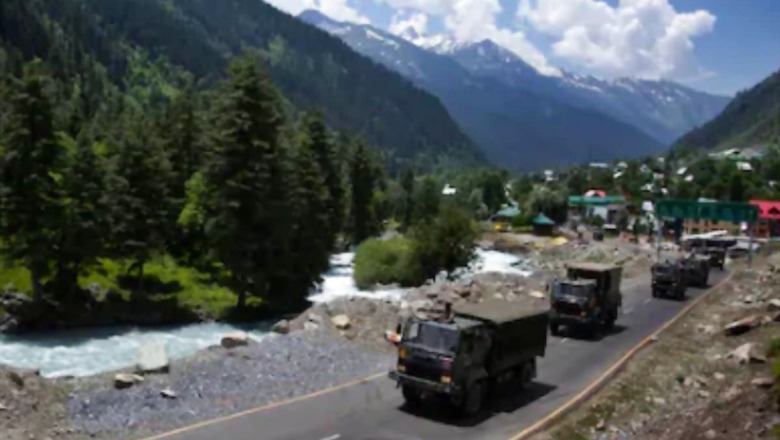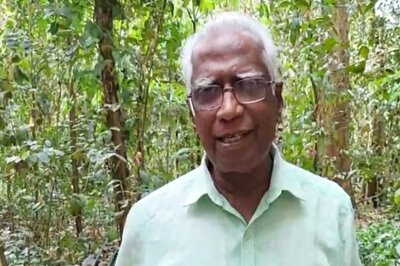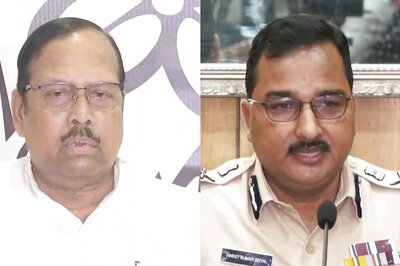
views
Confirmation that the PLA is not quite done with its plans in eastern Ladakh has come from the latest incident on the night of August 29/30. A statement by the Ministry of Defence’s official spokesman has said that “PLA troops violated the previous consensus arrived at during military and diplomatic engagements during the ongoing standoff in Eastern Ladakh and carried out provocative military movements to change the status quo.” They were pre-empted on this by the Indian Army.
What is surprising is the locale of the incident, in what the spokesman said was the “southern bank of Pangong Tso Lake”. Past incidents in the area have been in the Northern Bank in the now famous Finger Areas. Chinese actions now suggest that they continue to work along their plan seeking to shift the LAC westwards at the expense of the Indian side beyond their own previous claims.
In this case, strangely enough, they seem to be seeking to re-establish their claim in the Pangong Tso South Bank which, as per their position in the 1960 official talks, was at 78°43’E, 33°40’N. This as per GooglePro is roughly 1.5 kms into the Indian held portion of the LAC. However, and this is the main point of contention, the issue is the PLA presence in Finger 4 which is five kms to the west of their 1960 claim. Making sense of Chinese movements or their motivations is not an easy business.
All this has happened after five rounds of talks between the army officers of the two countries since the tensions bubbled up in April-May this year, suggesting the long haul and patient diplomacy. But at the same time, the need to remain alert to the somewhat opaque Chinese actions.
The 4,000 km Line of Actual Control that marks the border between India and China was, till April, considered one of the most peaceful disputed borders in the world. The last ‘hot’ incident there had occurred in 1975 at Tulung La in the eastern sector.
However, in the past two decades, as both sides improved the infrastructure along the LAC, things had begun to change. But a series of confidence building measures managed to keep peace, even though in several instances forces from both sides indulged in a great deal of pushing and shoving.
But such incidents were few and far between and in places that both sides knew were disputed. But in April this year, the PLA’s border guarding forces simultaneously moved forward in a number of places and included some, like the Galwan river valley, where there had been no issues in the past and now the attempt on the Pangong Tso South Bank. Their move was clearly a concerted bid to shift the LAC westwards in eastern Ladakh. That this was a carefully considered move became apparent from the fact that this movement was backed by an ominous buildup of regular PLA forces all along the LAC.
Efforts to utilise the existing mechanisms to draw down the tension failed spectacularly on June 15 when 20 Indian Army personnel were killed, more than 80 injured and 10 briefly captured. This has led to a train of events which are promising to make the LAC into a “hot” border.
After the June 15 incident, National Security Adviser Ajit Doval had a two-hour telephonic conversation with the Chinese Foreign Minister Wang Yi on July 5 and this led to a pull back of Chinese forces in the Galwan area. However, things have not changed elsewhere. The Chinese continue to occupy a key height in the Finger 4 area of the north bank of the Pangong Tso, as well as block Indian patrols in the Depsang region. They continue to maintain significant concentration of forces in the Gogra and Hot Springs area as well. And far from planning to withdraw, they seem to be planning new ventures.
There are other intriguing signs that things will remain hot. On August 29, Xi Jinping gave a call to two day Central Symposium on Tibet to build a “new modern socialist Tibet”. To this end, there was need to combat “separatist elements” and Sincise Tibetan Buddhism as well.
Tibet, he said, should be an “impregnable fortress” of stability. He called for the efforts to ensure national security and solidifying border defence and frontier security.. We can only speculate as to whether there is a direct link between Chinese actions on Saturday night, and the Central Symposium on Tibet in Beijing. But it has been clear for quite some time now that the need to maintain control over Tibet is at the heart of China’s India border policy.
From 1993 when India began to accept the concept of the “Line of Actual Control” there have been anywhere between 16-20 places where the claims of the two sides overlap. There are some 10 places in eastern Ladakh, 6 in the eastern sector and four in the central.
Here both sides would patrol up to their understanding of where the LAC lay. Both sides had worked out agreements and standard operating protocols to ensure that they did so without getting into clashes if and when they met. Earlier, given the infrastructure, such meetings were not common, but with the improved conditions on both sides, such meetings became more common, as did occasional clashes.
But in the mid 2000s, the Chinese stepped up their activities along the LAC. In part this was a result of their strengthening of their infrastructure, and in part a shift towards a more assertive policy. In an article written in 2008, when he was not a Congress party member, Shashi Tharoor accused the then UPA government of underplaying the Chinese incursions. He had, at the time, said that geopolitical factors were driving Chinese policy and “the Sino-Indian frontier is unlikely to remain quiet.”
Tharoor was prescient. The border has not been quiet and over the years the LAC has become hotter and hotter. The Depsang incident of 2013 was a harbinger of thing to come. The audacious Chinese incursion in Chumar during Xi Jinping’s visit to New Delhi in 2014 completely perplexed the Indian establishment. But both these incidents, as well as the Doklam crisis which was on Bhutanese territory, were managed through negotiations.
This time things look different and this is especially so after Saturday’s incident which has taken place after rounds of confabulations between the Indian and Chinese officials, and repeated claims of having reached a consensus on disengagement and de-escalation.
At present three divisions of the Indian Army confront two Chinese mobile divisions, an airborne brigade, and elements of two more brigades in eastern Ladakh. Given the terrain, Chinese forces are able to take advantage of mobility and they also possess a generous amount of fire power. The forces belong to the Xinjiang Military District.
Separately, Indian forces in the central sector, Sikkim and Arunachal face the Tibet Military District. Most forces in the east remain located away from the LoC but have the ability to move up fast in the excellent infrastructure the Chinese have in Tibet. After the Doklam incident, the Chinese have also begun a crash programme to upgrade their air bases and helipads in frontier regions.
Both the XMD and TMD are part of the Western Theatre Command that confronts Indian forces from the northern tip of Siachen Glacier to the India-China-Myanmar trijunction in the east.
India holds its side of the LAC strongly, and in fact has more troops forward than the Chinese. As abundant caution, it has begun moving reserves in several areas where it is anticipating trouble along the entire Line of Actual Control. Earlier this could be anticipated in places like Depsang, Pangong, Chumar or Barahoti or Sumdorong Chu, Asaphi La and Longju, now everything seems to be up for grabs.
Plainly and simply, the Chinese seem to be involved in coercive diplomacy to overawe India. So we need to figure out a counter-strategy to resist, and, in turn modify Beijing’s calculus.
This article was first published on ORF.



















Comments
0 comment